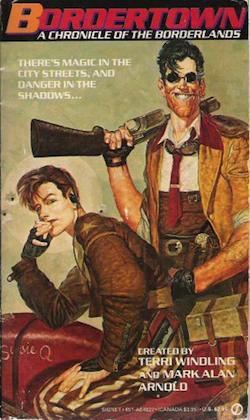Welcome to the Bordertown reread. Today’s post looks at the second of the anthologies published in this shared world, Bordertown. Unlike Borderland, which I read for the first time just before starting this series of posts, I’ve read Bordertown before, many times. I don’t remember exactly if it was this book or Elsewhere that was my way into Bordertown, but I do remember that once I got there, I never wanted to leave.
“There’s always been places that called to people.” So says Orient, in “Danceland,” the novella by Emma Bull and Will Shetterly that opens Bordertown, the second of the anthologies set in the shared world of the Borderlands. Bordertown, the city on the edge of the Borderlands, that half-magic place between the Elflands and the World, is one of the places that calls to people. The kind of people it calls to, and what they become when they arrive there, is what Bordertown is about.
In “Danceland,” we meet Orient, Tick-Tick, and Wolfboy, characters we’ll come to know better in Shetterly and Bull’s Bordertown novels, Elsewhere, NeverNever, and Finder. There’s a murder, and a mystery, and an Elven rock star, and a new arrival in Bordertown. There is always a new arrival in Bordertown - who wouldn’t want to run away to a place where the pervasive magic is the idea that anything can happen tonight?
The stories in this anthology, like all of the Bordertown stories, make clear that while Bordertown may be a magic place, one full of all types of different magics—one of my favorite characters is the chocolate-loving tanuki badger tea kettle in Midori Snyder’s “Demon”—it is far from a perfect one. As you might expect in any city, there is racism. There are gangs, and a thriving criminal element. Someone’s mother says that elves “don’t even have souls.” Magic doesn’t take away problems, it just gives them a different canvas to paint themselves across. Anything can happen here, and what does isn’t always good.
Snyder’s “Demon,” along with Bellamy Bach’s “Exile” asks us to question our definitions of what makes a monster. One thing you learn early on along the Border is that what something or someone looks like is next to useless when it comes to learning who they are. The monstrous and the good rarely wear their expected shapes in Bordertown, and sometimes, the shapes the city’s denizens wear shift.
Ellen Kushner and Bellamy Bach take the idea that no one is stuck inside one skin forever and run with it in “Mockery,” where identities are cast off and tried on and cast off again, and “fake it ’til you make it” is given glorious life. The fools of Bordertown are born here.
The story, and the anthology, quietly close with the realization that another of Bordertown’s pervasive magics is that while the city belongs to everyone, and wears a different face for us all, we, too, get to choose the face we wear when we dwell in Bordertown. Maybe we get that choice even before we cross the Border.
For all that the setting is so important, the creation of this place that calls to people, invites them to find themselves and make a home among the glittering broken, such a necessary part of this volume, the worldbuilding is remarkably delicate. Here, and in the preceding anthology, Borderland, the setting is built in a series of subtleties. Since so many people come new to Bordertown, there are always new eyes to discover things, and show them to the readers - to ask where the good bar is, or the best dance music, or be disappointed that they didn’t get a cooler nickname upon arrival. There are always people new enough, still wearing the fashions of the World, to make a lifelong B’town resident think that “Hell’s Angels” is a pretty cool name for a band. Where these people meet, the new and the old, somewhere along the border of the known and the mysterious, is where the magic of the city lives.
When I read these books now, I feel like I’ve always known not to drink Mad River water, no matter how thirsty I am, or that one ought to put on one’s best finery when taking tea on Dragon’s Tooth Hill. But if I look critically at the details, it’s hard to pull out the pieces that made me recognize Bordertown as my kind of magic, as a place I wanted to call home, when I first read the books. Bordertown could be almost any city, half-broken, half-magic, full of people looking so very hard to find themselves.
It’s that, I think, that is Bordertown’s magic: that it is recognizable as well as strange, and anything can happen there on any given night. Bordertown is one of those places that calls to people. It’s still calling.
Kat Howard‘s short fiction has been published in a variety of venues. You can find her on Twitter, at her blog, and at Fantasy-matters.com. She still wants to live in Bordertown.










